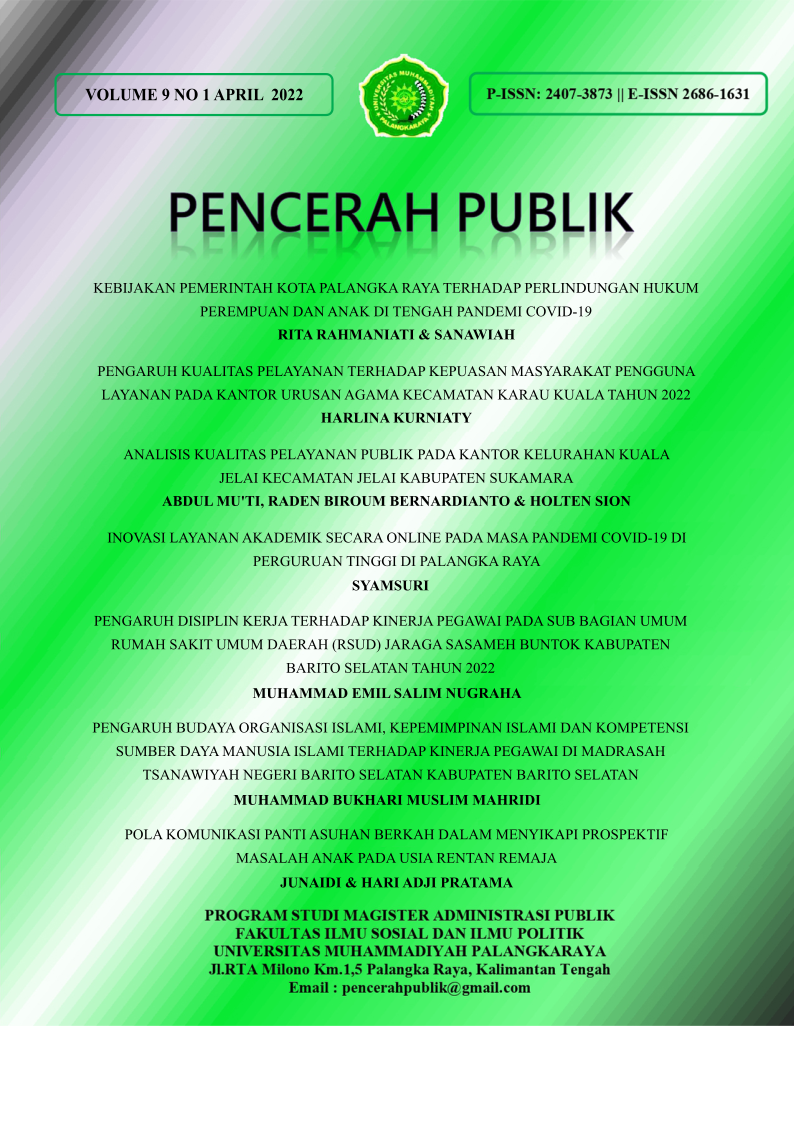Communication Patterns of Berkah Orphanage in Addressing the Prospective Problems of Children at Vulnerable Adolescent Ages Pola Komunikasi Panti Asuhan Berkah dalam Menyikapi Prospektif Masalah Anak pada Usia Rentan Remaja
Main Article Content
Abstract
This study aims to identify the communication patterns implemented at Panti Asuhan Berkah in nurturing children during the vulnerable adolescent stage to prevent social behavior problems. The method employed is a qualitative approach, with data collected through observation, in-depth interviews, and documentation. The results reveal that both verbal and non-verbal communication patterns are intensively applied by the caregivers, accompanied by an approach based on affection and role modeling. This communication pattern contributes approximately 65% to the success of character development among the foster children. Challenges encountered include the limited number of caregivers and the diverse characteristics of the children. This study recommends the importance of enhancing caregiver capacity and intensifying personalized approaches.
Downloads
Article Details

This work is licensed under a Creative Commons Attribution-ShareAlike 4.0 International License.
Authors who publish with this journal agree to the following terms:
- Any article on the copyright is retained by the author(s).
- Author grant the journal, right of first publication with the work simultaneously licensed under a Creative Commons Attribution License that allows others to share work with acknowledgment of the work authors and initial publications in this journal.
- Authors are able to enter into a separate, additional contractual arrangements for non-exclusive distribution of published articles of work (eg, post-institutional repository) or publish it in a book, with acknowledgment of its initial publication in this journal.
- Authors are permitted and encouraged to post their work online (e.g., in institutional repositories or on their websites) prior to and during the submission process, as can lead to productive exchanges, as well as earlier and greater citation of published work.
- The article and any associated published material is distributed under the Creative Commons Attribution-ShareAlike 4.0 International License
References
Ali, M., & Asrori, M. (2011). Psikologi remaja: Perkembangan peserta didik. Bumi Aksara.
Baumrind, D. (1991). The influence of parenting style on adolescent competence and substance use. Journal of Early Adolescence, 11(1), 56–95.
DeVito, J. A. (2011). The interpersonal communication book (13th ed.). Pearson Education.
Djamarah, S. B. (2004). Psikologi belajar. Rineka Cipta.
Erikson, E. H. (1968). Identity: Youth and crisis. W. W. Norton & Company.
Hurlock, E. B. (1980). Developmental psychology: A life-span approach (5th ed.). McGraw-Hill.
Lasswell, H. D. (1948). The structure and function of communication in society. In L. Bryson (Ed.), The communication of ideas (pp. 37–51). Harper and Brothers.
Lickona, T. (1991). Educating for character: How our schools can teach respect and responsibility. Bantam Books.
Lisnawati, L. (2019). Strategi Komunikasi Komisi Penanggulangan AIDS (KPA) Provinsi Kalimantan Tengah dalam Menyosialisasikan Penanggulangan HIV dan AIDS di Kalimantan Tengah: An Analysis of Service Quality, Competence and Performance of Pokjar Administrators in Relation to Student Satisfaction at UPBJJ-UT of Palangka Raya. Anterior Jurnal, 19(1), 130-136.
Miles, M. B., & Huberman, A. M. (1994). Qualitative data analysis: An expanded sourcebook (2nd ed.). Sage Publications.
Papalia, D. E., & Olds, S. W. (1987). Human development (4th ed.). McGraw-Hill.
Sarafino, E. P. (2007). Health psychology: Biopsychosocial interactions (5th ed.). John Wiley & Sons.
Setyowati, Y. (2005). Pola komunikasi keluarga dan perkembangan emosi anak (Studi kasus penerapan pola komunikasi keluarga dan pengaruhnya terhadap perkembangan emosi anak pada keluarga Jawa). Jurnal Komunikasi, 2(1), 67–78.
Whalroos, D. I. (2002). Family-centered communication: A guide for health care providers. Slack Incorporated.
Yuliawati, R., Setiawan, A., & Mulya, D. S. (2007). Kesepian pada remaja dari keluarga bercerai. Jurnal Psikologi, 34(2), 101–115.
